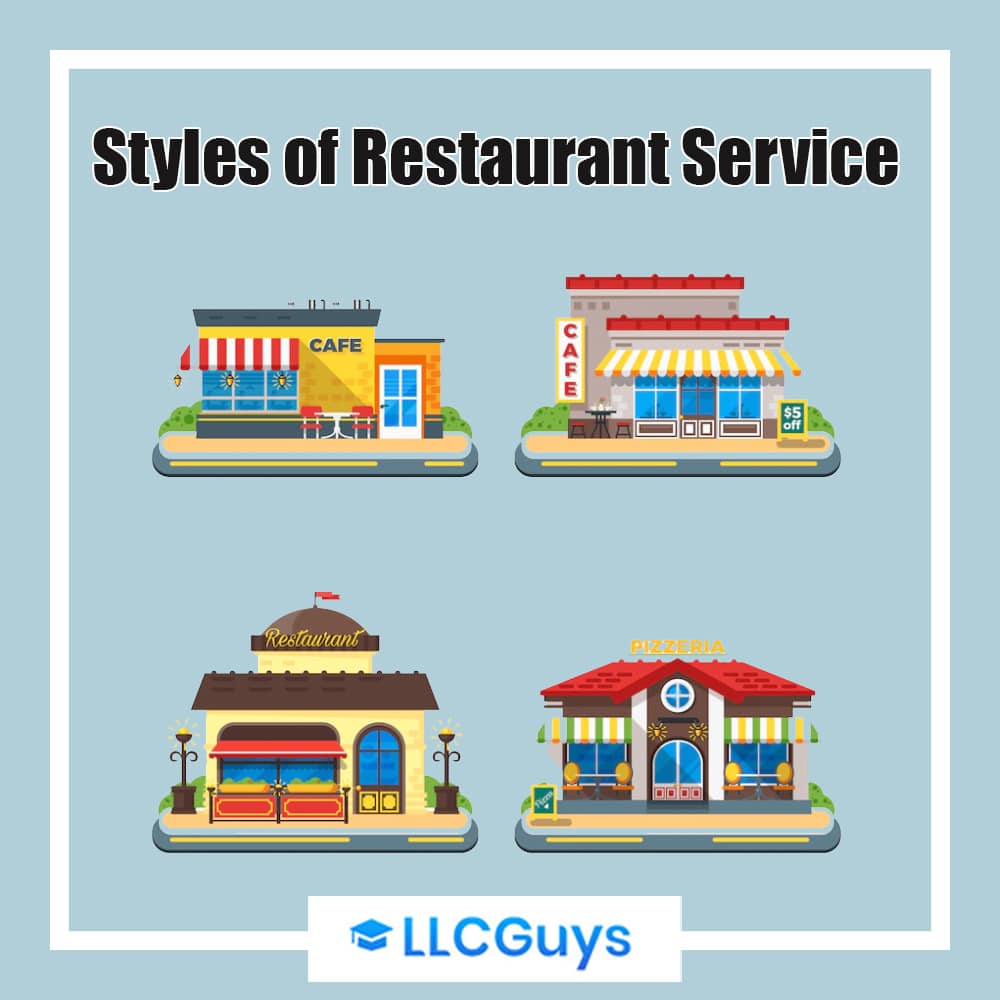How to Start a Restaurant Business- A Comprehensive Guide for New Entrepreneurs
1st Things 1st — Start an LLC For Your New Restaurant Business

It may appear difficult for aspiring restaurateurs to keep up with the constantly evolving food service sector. There are plenty of trends for foodies searching for a distinctive eating experience, from food trucks to weekend brunch. Plus, with the COVID-19 epidemic causing an increase in outside dining, superb cuisine isn’t enough to attract people searching for outdoor sitting. However, while there are new and more difficulties for restaurant owners than in previous years, there are some fundamental factors that will never change when it comes to opening your own restaurant.
It’s very important to have an LLC for your 1st restaurant and it’s a crucial step as well. Consider hiring a professional company to do all the legal stuff for you:
- 1st Things 1st — Start an LLC For Your New Restaurant Business
- Styles of Restaurant Service
- Food Concept Selection
- Carving Your Specialty
- Employed at a Restaurant
- Business Plan: How to Write It?
- Starting a Real Business – Is It Costly?
- Location Selection For Your New Restaurant
- Restaurant Interior Layout Structure
- Establishing an Attractive Menu
- Thing to Think About: Regulations on Safety
- Employee Recruitment Process
- Getting Professional Help to Start Your LLC for Your New Restaurant Business
- In Conclusion
However, the harsh fact is that many restaurants fail in their first year, often owing to a lack of preparation. However, this does not imply that your food-service operation must be highly complicated. In fact, the more streamlined it is, the higher your chances of success will be.
To assist you in getting started, we’ve put up this comprehensive yet easy-on-understand guide to beginning your own food business. Start your business research here, whether you want to create a Las Vegas wine bar, an Irish pub famed for its craft beer, a New York-style pizza, a North Carolina soul food restaurant with the greatest fried chicken, or a downtown fine dining experience with happy hour drinks and live music.
Contents Included:
- Restaurant Service Styles Target Markets
- Creating a Niche
- How to Write a Business Plan
- Location Selection
- Establishing a Menu
- Employee Recruitment Marketing and Promotions
There is no such thing as a universally appealing restaurant. Many newer entrepreneurs struggle to accept this reality, but the truth is that you will never be able to grab 100% of the market. You will please no one if you strive to please everyone. So concentrate on the 5 to 10% of the market that you can capture and ignore the rest.
So, who is dining at restaurants these days? Consider the following market segments for food-service industry customers:
- Millennials. The “millennial generation,” often known as the “echo” or “boomlet” generation, comprises people born between 1980 and 2000. Generation Y is the most ethnically varied generation yet, with a population nearly three times that of Generation X. They are an excellent target for a restaurant. Generation Y prefers fast food and quick service restaurants. Burger franchises account for around 25% of their restaurant trips, with pizza places accounting for 12%.
- X Generation. The term “Generation X” refers to those born between 1965 and 1980. Family values are important to this group. While previous generations strived to outperform their parents monetarily, Gen Xers are more inclined to prioritize their relationship with their offspring. They care about price and like quick-service restaurants and midscale establishments with all-you-can-eat salad bars and buffets. To appeal to this target segment, create a welcoming environment that emphasizes value and ambiance.
- Baby boomers. Those born between 1946 and 1964, are the biggest generation in the United States. Affluent professionals who can afford to attend premium restaurants and spend money freely are prominent in this age. They were the dominant consumer demographic for upmarket, fashionable restaurants in the 1980s. Many baby boomer homes with children in the 1990s were two-income households. Restaurants that offer a family-friendly ambience, as well as those that provide an elite, formal dining experience, are targeting people on the front edge of the boomer generation who are becoming grandparents.
- Nesting parents. This demographic includes those between the ages of the baby boomers and the elders (people in their early 50s to about age 64). Empty nesters often have grown children who no longer live at home, and their numbers are expected to expand as the baby boomers age and their children leave home. This generation frequently attends luxury restaurants since it has the greatest discretionary spending and the highest per-capita income of all the generations. They are more concerned with superb service and wonderful cuisine than with money. Elegant settings and a refined atmosphere will appeal to this group.
- Seniors. The senior market includes a huge demographic of adults aged 65 and up. Most seniors are on fixed incomes and may not be able to afford sophisticated restaurants on a regular basis, so they prefer to eat at family-style restaurants with decent service and moderate costs. “Younger” elders are more active and likely to have more discretionary money than “older” seniors, whose health may be deteriorating. Because their appetites are less than those of younger people, seniors like eateries that offer early-bird discounts and senior menus with cheaper pricing and smaller quantities.
Styles of Restaurant Service

Quick-service, midscale, and premium restaurants are the three main types of restaurants. Fast-food restaurants are sometimes known as quick-service restaurants. These restaurants have a small menu of products that are produced fast and offered for a low price. They usually have driven-thru windows and take-out service in addition to relatively informal eating places.
People commonly associate fast-food restaurants with hamburgers and French fries, although fast-food restaurants also sell chicken, hot dogs, sandwiches, pizza, fresh fish, and ethnic dishes.
As the name indicates, midscale restaurants fall between quick-service and premium dining. They serve substantial meals at pricing that people feel to be fair, with a variety of special deals. Limited- and full-service choices are available at midscale restaurants. Client’s place and receive orders at their tables in a full-service restaurant; at a limited-service establishment, patrons purchase food at a counter and then get their meals at their tables. Salad bars and buffets are common at limited-service restaurants.
Upscale restaurants provide full table service and do not always advertise their meals as being inexpensive; instead, they emphasize the quality of their cuisine and the ambiance of their establishments. These are the sites that travelers searching for superb meals from a renowned chef will discover on a list of vacation ideas. Fine-dining restaurants are at the top of the luxury restaurant food chain, with the highest costs.
Food Concept Selection

Restaurant customers want to be thrilled with their eating experience, but not necessarily shocked. If you expect a family-style steakhouse based on the name or décor, but instead find yourself in a more formal setting with a befuddling—and expensive—gourmet menu, the surprise may prevent you from enjoying the restaurant. Concepts allow restaurateurs to tell customers what to anticipate in advance while also providing structure to their business. Some of the most popular restaurant concepts include:
Carving Your Specialty

You must first pick which section of the food-service industry you wish to enter before you can begin real business planning. While the various types of food-service businesses have many similarities, they also have numerous variances. While the information and abilities required for success are similar, your personality and interests will determine whether you create a commercial bakery, a coffee cart, a fine-dining restaurant, or another sort of business. Then, once you’ve selected which business is ideal for you, you must determine which market niche you’ll fill.
Do you like to get up early or stay up late and sleep late, for example? A bakery or a casual breakfast-and-lunch establishment can be your specialty if you enjoy (or at least don’t mind) waking up early. The hours necessary for bar-and-grill eateries, fine-dining businesses, and even pizzerias will appeal to night owls.
Do you prefer dealing with the general public or working in the kitchen? Choose a food-service business that allows you to interact with your clients frequently if you’re a people person. If you’re not particularly outgoing, you’ll generally gravitate toward a commercial venture, such as a bakery or a catering service, where you can focus on operations rather than people.
Other questions to consider include: Do you have an affinity for a certain cuisine? Do you like a consistent daily routine or something different every day? Are you prepared to take on the additional obligations and risks that providing alcoholic beverages entails?
Consider your perfect day while you conduct this self-analysis. What would you be doing if you could do everything you wanted?
It’s time to see whether you can build a niche in the market for your food-service business once you’ve decided on the ideal specialty for you as an individual.
Employed at a Restaurant

A restaurateur’s various responsibilities include dealing gracefully with clients and serving as an exquisite host. Operators of food-service businesses spend the majority of their time developing menus, ordering inventory and supplies, managing personnel, creating and implementing marketing campaigns, ensuring compliance with a plethora of local, state, and federal regulations, completing a variety of paperwork, and performing other administrative tasks. While the financial benefits and entertaining components of the company are undeniable, beginning, maintaining, and developing a food-service business is also difficult.
Working for a similar organization before going out on your own is the greatest way to learn the ropes, regardless of the sort of food-service business you want to establish. This will provide you with valuable insight into the business’s reality and logistics.
Successful restaurateurs agree that working at someone else’s restaurant is the finest preparation for owning one. Consider it as getting paid to learn. You should study books and attend classes, but you should also intend to work in a restaurant for at least a few years, doing a variety of positions. And if you’re not performing the work, pay attention to the person who is since you could end up doing it yourself if your own restaurant is unexpectedly shorthanded.
You should ideally work at a restaurant that is comparable to the one you intend to start. You may discover that you dislike the industry. You can also discover that you’re better suited to a different sort of business than you imagined. Hopefully, you’ll find that you’ve arrived to the proper location.
“I understood this was my passion as soon as I started working in a restaurant,” Scott Redler says. “When you have a busy restaurant and you’re watching everything go as it should, it’s simply a beautiful feeling of fulfillment.” Redler spent 11 years working in restaurants before opening a Chinese fast-food joint at the age of 26. After that enterprise collapsed after eight months, Redler moved to work for a huge restaurant corporation, rising to the rank of senior vice president, controlling 15 operations. But he still desired his own space, so he created the Timberline Steakhouse & Grill idea in Kansas (which he sold in 2011). He saw the fast-casual category growing in popularity and decided to open Freddy’s Frozen Custard, which serves hot dogs, hamburgers, and, of course, frozen custard. Freddy’s Frozen Custard has 60 locations in nine states and is now a franchise.
Business Plan: How to Write It?

You’re ready to put together your business plan, the most important aspect of your restaurant, now that you’ve gained some experience. Before you buy the first spoon or break the first egg, make a plan on paper.
A clear definition of your concept; a description of your market; your menu and pricing; detailed financial information, including data on your startup capital (amount and sources) and long-term income and expense forecasts; a marketing plan; employee hiring, training, and retention programs; and detailed plans that outline how you’ll deal with the challenges restaurateurs face every day should all be included in your business plan. It’s also a good idea to include an exit strategy in your strategy.
Starting a Real Business – Is It Costly?

The amount of money required to start a business is determined by the type of business, the location, the quantity of equipment required, whether new or used equipment is purchased, inventory, marketing, and essential operational capital (the amount of cash you need on hand to carry you until your business starts generating cash). It is simple to invest hundreds of thousands of dollars to open a restaurant, but it is not necessary. For example, when Jim Amaral of Borealis Bread opened his first bakery in Maine, he hired a building that had previously been a commercial bakery and had mixers, benches, ovens, and other equipment. He was able to get started with just $10,000 borrowed from family and friends, which he put into inventory.
Regardless of how much money you require, you will require cash to begin a food-service business. Here are some ideas about where to get funding for your startup:
Location Selection For Your New Restaurant

You may spend anywhere from $70,000 to $1.5 million on a facility, depending on how much money you have to invest in your food-service business and the sort of business you pick.
Not every food-service enterprise needs to be in a retail location, but for those that do, here are some things to think about when choosing a location:
Sales volume expected. What role will the location have in your sales volume?
Potential customers’ accessibility. Consider how simple it will be for clients to enter your establishment. Consider whether surrounding companies will produce foot traffic for you if you rely on substantial pedestrian traffic.
- The ability of your company to pay rent. You’ll know how much income you can anticipate earning if you’ve done a sales-and-profit prediction for your first year of business, and you can use that information to determine how much rent you can afford to pay.
- Restrictive legislation. You may come across exceptionally stringent laws that make an otherwise strong location less than ideal, such as restrictions on truck loading and unloading hours.
- The Density of Traffic You may estimate the sales potential of each person passing a specific site by carefully examining food traffic. In this research, two parameters are particularly important: total pedestrian traffic during business hours and the percentage of that traffic that is likely to patronize your foodservice establishment.
- Parking lots for customers. Customers should have easy access to the property as well as convenient, enough parking.
- Location in relation to other companies. Neighboring companies can have an impact on your store’s volume, and their existence can either help or hurt you.
- Site’s History. Before you make a final decision, investigate the recent history of each site you’re considering. Who were the previous occupants, and why did they leave?
- Lease conditions. Make sure you understand all the conditions of the lease because even a great location might have poor lease terms.
- Future advancement. Check with the local planning board to see whether anything is planned that might have an impact on your business, such as new buildings or road construction.
Restaurant Interior Layout Structure

The layout and design of your restaurant are critical to its success. The size and arrangement of the dining area, kitchen, storage space, and office must all be considered. Restaurants typically dedicate 45 to 65 percent of their space to the eating area, 35 percent to the kitchen and prep area, and the balance to storage and office space.
- Dining room. Don’t cut corners while creating your dining area because this is where you’ll be making the most of your money. Examine the décor of eateries in your region. Keep an eye on the diners to see how they respond to the decor. Is it comfy, or do people move around in their seats during their meals? Take note of what works and what doesn’t.
Your dining room decor will be heavily influenced by your concept. It may be useful to know that 40 to 50 percent of all sit-down customers arrive in pairs; 30% arrive alone or in groups of three; and 20% arrive in groups of four or more, according to research.
Use tables for two that can be pulled together in spaces with plenty of floor space to accommodate the various groupings of clients. This allows you to accommodate both small and large gatherings. Along the walls, set up booths for 4 to 6 individuals.
Area for production. Too often, the restaurant’s production space is inefficiently built, resulting in a disorganized kitchen and subpar service. As you determine each piece in the manufacturing area, keep your menu in mind. Receiving, storage, food preparation, cooking, baking, dishwashing, production lanes, garbage storage, staff amenities, and a small office where you may execute daily managerial activities are all required.
Arrange your meal preparation space such that everything is within easy reach of the chef. During your busiest hours, your design should also allow two or more cooks to work side by side.
Establishing an Attractive Menu

Be mindful of the following trends in menu content and design when you put together a strategy for your food-service business: These criteria can—and should—influence the sort of food-service establishment you create.
Vegetarian products, tortillas, locally grown vegetables, organic items, fusion meals (combining two or more ethnic cuisines in one dish or on one plate), and microbrewer or local beers are also increasing appeal, according to restaurant owners. Pita dishes and wraps are also in high demand as a quick and fast alternative to sandwiches. Bagels, espresso, specialty coffees, and “genuine meals,” which are often an entrée with a side order, will also be in high demand. In addition, consumers are consuming more poultry, fish, and beef meals than in previous years. People, on the other hand, anticipate vegetarian options on the menu. Consumers are also clamoring for “comfort food,” or recipes that transport them back to their childhoods when moms baked from scratch and meat and potatoes dominated each plate.
There are also a variety of ethnic meals and spice-infused options on the menus. Thai, Vietnamese, Creole, Tuscan, and even classic French cuisines can all be found on the same menu and even on the same dish.
At the same time, keep the children in mind when you make your decisions. If your target market includes a lot of families, you’ll want a selection of four or five things in smaller servings that kids will like. If you provide both snacks and meals, keep in mind that, owing to conscientious parents, kids are choosing healthier snacks more often than they were a few years ago. While both sweet and salty snacks remain popular, yogurt is the fastest-growing snack item in terms of frequency of intake among children aged 2 to 17. While most restaurants still serve pre-made children’s meals, you can try letting your children choose from a variety of healthy selections.
Even though menu diversity has expanded over time, menu length has decreased. Consumers who are pressed for time don’t want to peruse a lengthy menu before dinner; dining out is a leisure activity, and they are there to unwind. Reduce the number of items on your menu and keep the menu descriptions clear and plain, so that clients have a variety of options in a short time. Your menu should also specify which items may be made to accommodate dietary needs. Low-fat, low-sodium and low-cholesterol foods should be labeled as such.
Thing to Think About: Regulations on Safety

Though we don’t think of food service as being as severely regulated as medical services or public utilities, the fact is that many parts of your business are regulated and subject to inspection. If you don’t follow the rules, you risk being fined or having your business shut down. If the infractions include contaminated food, you might be held liable for the diseases and even deaths of your customers. Sanitation and fire safety are major concerns. You must create a safe atmosphere for your workers to work and dine in, adhere to your state’s alcohol and tobacco product sales rules, and address tax concerns such as sales, beverage, payroll, and more.
Most regulatory bodies will engage with new operators to help them understand what they need to do to comply with the law. The general information office in your state can lead you to all of the agencies you’ll need to deal with.
Employee Recruitment Process

A shortage of competent personnel is one of the most significant difficulties that firms in all sectors confront. As the foodservice sector continues to develop and prosper, so does the need for workers in an already shrinking labor pool. Two major worries for food-service business owners are finding skilled staff and growing labor expenses.
The first step in creating a thorough HR program is deciding what exactly you want someone to perform. The job description doesn’t have to be as formal as the one you’d find in a huge organization, but it should clearly describe the tasks and responsibilities of the position. It should also include any necessary abilities or credentials, such as a valid driver’s license and a clean driving record for someone making deliveries for you.
The next step is to create a wage scale. You should conduct research to determine the wage rates in your location. For each position, you should set a minimum and maximum rate. You’ll pay extra for higher skilled and experienced staff right away. Of course, whether or not the position is routinely tipped will have an impact on the pay scale.
Even if the applicant is someone you already know and has supplied a complete CV, every prospective employee should fill out an application. The application, which contains a truth affidavit, is a signed, sworn statement confirming that you can terminate the person if he or she lies about his or her past. You should compare the two and make sure the information is similar. The application will also help you verify the candidates’ resumes.
Here are some pointers to help you locate and retain excellent employees:
- Hire wisely. Take your time while screening applications. Make certain they understand your expectations. Check your background. If you can’t handle it alone, hire an HR expert to help you on a project-by-project basis.
- Make thorough job descriptions. Make no assumptions about your workers’ obligations.
- Understand the laws governing wages, hours, and child labor. Check with your state’s Department of Labor to make sure you’re following the rules on things like minimum wage (which varies based on the age of the employees and whether they’re eligible for tips), and when and what teens can do.
- Report all tips correctly. The IRS is quite particular about how tips should be recorded; check with your accountant or contact the IRS for further information.
- Initial and continuous training is provided. Even seasoned employees must understand how things are done at your business. Employees that have been properly taught are happier, more confident, and more productive. In addition, continuing training fosters employee loyalty and decreases turnover. The National Restaurant Association can assist you in creating effective employee training programs.
In the restaurant industry, there are numerous types of employees: managers, chefs, waiters, busboys, dishwashers, hosts, and bartenders. Some workers’ responsibilities may cross over from one category to another when your restaurant is still fresh. Your boss, for example, may also function as the host, and servers may bus tables. Make sure to recruit personnel who are willing to adjust their work schedules. Payroll costs, including your own and your managers’ salaries, should account for 24 to 35 percent of total gross sales.
- Manager. In most restaurants, the manager is the most important employee. Your ideal applicant will have already managed one or more restaurants in your region and will be familiar with local purchasing sources, suppliers, and processes. You’ll also want a manager with leadership abilities and the ability to supervise employees while maintaining the restaurant’s style and identity.
You’ll have to pay a lot of money to acquire the manager you desire. Expect to pay a seasoned manager $35,000 to $55,000 per year, plus a percentage of revenue, depending on your area. An entry-level manager will earn between $28,000 and $32,000 a year, but will lack the expertise of a more experienced candidate. If you can’t pay a large wage, figure out a profit-sharing plan; it’s a great approach to attract competent employees and inspire them to help you establish a successful business. Hire your manager at least a month before your restaurant opens so that he or she can assist you with the setup.
- Cooks and chefs. You’ll probably need three cooks to begin with, two full-time and one part-time. Restaurant employees often work 10 a.m. to 4 p.m. or 4 p.m. to closing hours. However, one head cook may need to arrive early in the morning to start cooking soups, bread, and other dishes for that day’s service. One full-time cook should work during the day and the other throughout the evening. During high hours, such as weekend rushes, the part-time cook will assist, and during calmer moments, he or she will work as a line cook, completing easy preparation. Cooking schools can typically refer you to the best in the industry, but do some research and publish newspaper advertising before hiring. Only if customers know they can get the finest every time they visit your restaurant will they become regulars. To do so, you’ll need top-tier chefs and cooks.
Chefs and cooks are paid differently depending on their expertise and the menu. Chefs earn substantially more than cooks, earning $1,300 to $1,800 per week on average. Chefs who are prepared to work on a profit-sharing basis may also be found. You may have to spend between $575 and $650 a week if you have a very extensive menu that necessitates the services of an experienced cook. Part-time cooks can be paid on an hourly basis; shop about for the common rate in your region.
- Servers. Customers will deal with your servers the most, so they must make a good first impression and operate effectively under pressure, addressing the needs of several tables while keeping a nice manner. For wait staff, there are two periods of day: extremely slow and highly busy. Appropriately schedule your personnel. For example, the lunch rush begins about 11:30 a.m. and lasts until 1:30 or 2 p.m. Restaurants are frequently sluggish until the dinner crowd arrives about 5:30–6 p.m.
Because servers in most businesses rely on tips for a large percentage of their revenue, they are frequently paid minimum wage or somewhat more. When starting a new restaurant, you may wish to recruit solely experienced waiters to avoid having to undergo significant training. However, as your business grows, you need to implement training programs to help both new and seasoned employees grasp your philosophy and the image you want to present.
Getting Professional Help to Start Your LLC for Your New Restaurant Business
It can be difficult and time-consuming to form an LLC yourself. Since it requires quite a lot of paperwork, knowing what and when to file, how to obtain an EIN and etc. That’s why over 95% of entrepreneurs actually choose to hire a professional service to oversee all the processes for them so they can actually focus on what’s important – their business (in your case — your new restaurant).
That’s why we compiled our most favorite and client-loved LLC formations services. You can also read our top-LLC services guide here as well.
#1 – ZenBusiness Can Help You Form an LLC for Your Restaurant
ZenBusiness provides LLC creation services at a low cost and with several useful features. Most LLCs will benefit from two of these aspects. All ZenBusiness’s products include a year of complimentary registered agent service. With their Pro and Premium Packages, they offer to ensure worry-free compliance. ZenBusiness will file your yearly report and notify you if there is anything further you need to do to follow the state under this assurance.
They have a customer satisfaction rating of 98% and over 4500+ verified reviews.
For a full Zenbusiness review – click here.
#2 – Create an LLC With Northwest Registered Agent
With decades of expertise, Northwest Registered Agent is an exceptional LLC creation service. They deliver excellent, well-informed customer service. Their biggest benefit, though, is the seclusion they provide. They don’t outsource any of their services to third parties, don’t sell your information, and even build their own code.
They have a customer satisfaction rating of 98 percent and over 4300+ verified reviews. They’ll come with a complimentary year of registered agent service!
Here’s our in-depth Northwest review.
In Conclusion
The concept of owning a restaurant is fantastic. However, beginning a restaurant from the ground up and effectively running it is a huge undertaking. We hope that this guide has helped you learn how to establish a restaurant company.





